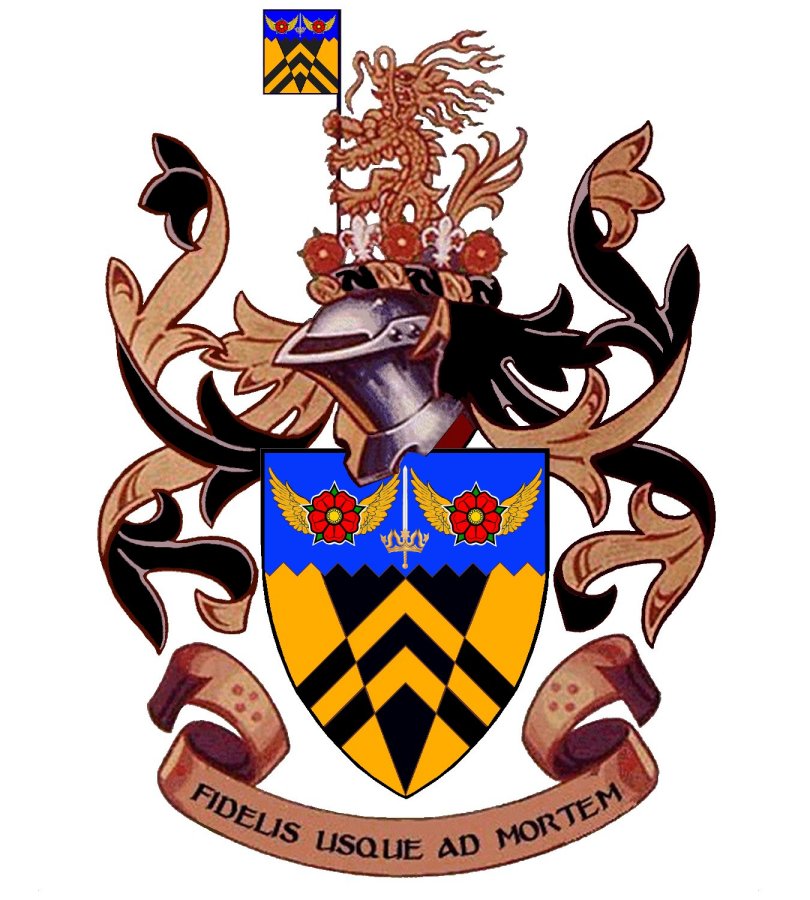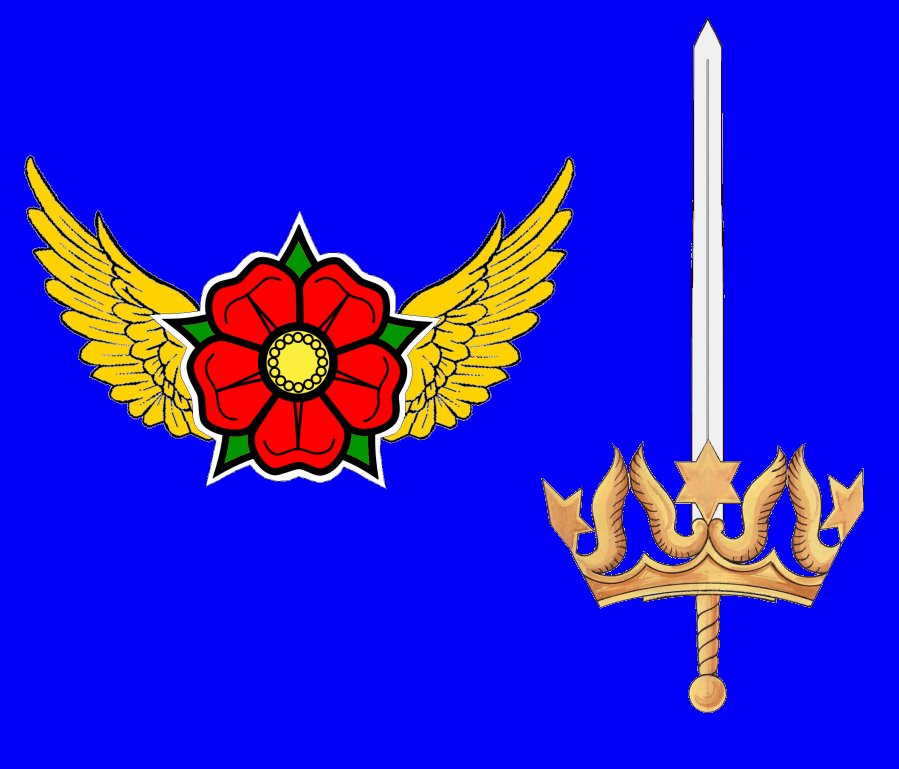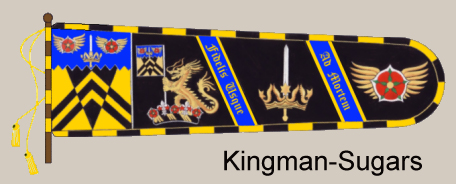
Geoff Kingman-Sugars, J.P., F.I.A.A.H.
Australia

 |
 |
Badges |
Standard |
Artist: College of Arms
Registered in The Chinese Armorial, March 27, 2013.
Arms: Or a Pile and two Chevronels Sable counterchanged on a Chief indented Azure between two Roses Gules barbed and seeded proper fimbriated Argent winged gold a Sword point upwards proper the quillons in the form of an Astral Crown hilt and pommel Or.
Crest: On an Esquire’s helm with a wreath Or and Sable within a Circlet of Roses Gules barbed and seeded proper and Fleurs-de-Lys Argent each charged on its dexter and sinister lobe with a Mullet Sanguine a Chinese Dragon rampant Or armed and langued Gules supporting a Flagpole Sable flying therefrom to the dexter a Banner of the Arms.
Motto: Fidelis Usque ad Mortem (Faithful Even Unto Death)
Badge #1: a sword erect proper, the quillions in the form of an astral crown Or, hilted and pommeled Or.
Badge #2: a Rose Gules, barbed and seeded proper, fimbriated Argent, winged gold.
Standard: In the hoist the arms of Geoffrey John Kingman-Sugars and in the fly Sable, between two transverse bands Azure fimbriated Or, bearing the motto Fidelis Usque ad Mortem in letters Or, in the first compartment his crest, namely on a wreath Or and Sable, within a circlet of roses, Gules, barbed and seeded proper, alternated with as many fleurs-de-lis Argent, charged on the dexter and sinister lobes with a mullet Gules, a Chinese dragon rampant Or armed and langued Gules, supporting a pole Sable, flying therefrom to dexter his heraldic banner, in the second compartment a sword erect proper, the quillions in the form of an astral crown Or, hilted and pommeled Or, in the third compartment a rose Gules, barbed and seeded proper, fimbriated Argent, winged Or; the sleeve Sable, fringed compony Or and Sable.
Grant of arms: College of Arms, March 25, 1981.
Registration of standard: Bureau of Heraldry (South Africa), certificate 3442, July 30, 2004.
The badges were not registered or granted separately but are charges on the coat of arms and the standard.
Background and History:
The coat of arms was granted to Geoff Kingman-Sugars but also with the provision that they can be used by his late father Bertram Ewart Sugars' other descendants with appropriate differencing.
Geoff Kingman-Sugars' parents were permanent residents of Hong Kong from 1933 onward, and he was born there as well. His father was second in charge of Hong Kong Government Stores and was a Captain (Acting Major) of the Hong Kong Auxiliary Ordnance Corps (ex-Hong Kong Volunteer Defense Force) and was interned in Hong Kong during the Japanese occupation 1941-1945. After World War II, the father resumed his position in the Hong Kong Government until his retirement in late 1959.
The design of the arms symbolizes both the armiger's and his father's personal histories, which are greatly involved in the military and aviation.
The colours black and yellow are from the black-and-yellow checkered flag used in air traffic control and symbolize the armiger's professional career as an Air Traffic Controller.
The azure (blue) chief represents the sky and symbolizes aviation, in which both the armiger and his father were involved at a young age. The armiger learned to fly an aircraft at age 17 in Hampshire, England, and the rose is the symbol of both the county of Hampshire and the country of England. The sword symbolizes that both the armiger and his father were military officers. In addition to serving in the Hong Kong Auxiliary Ordnance Corps in World War II, his father was in the Royal Naval Air Service (RNAS) and Royal Air Force (RAF) in World War I. The armiger was in the British Army and the Royal Australian Air Force after World War II.
The armiger asked for an astral crown as his crest coronet. The College of Arms declined his request on the grounds that the astral crown was reserved for use by aviation corporations or Officers of Air Rank only. He petitioned for use of the astral crown on the basis that his father was a founding member of the Royal Air Force, so the College of Arms included the astral crown as part of one of the charges, as the quillons of the sword. Compared to use as a crest coronet, this is a relatively minor use of the astral crown, but nonetheless, it is in the coat of arms.
The crest coronet is a circlet of alternate roses and fleurs-de-lis. The roses symbolize that the armiger learned to fly in England, and the fleurs-de-lis symbolize that his father learned to fly at the RNAS Station at Vendome in France in 1917. The fleurs-de-lis also symbolize the Scouting movement, in which the armiger was involved for twenty-four years, both in the aviation sphere and the Venturer Scout section of the movement. The fleurs de-lis have mullets (five-pointed stars) on their lobes to resemble the World Badge for the Scout Movement at the time.
The Chinese dragon symbolizes that the armiger was born in the Year of the Dragon and in Hong Kong and that his father who was a Senior Government Official in the Hong Kong Colonial Administration and a prisoner of war from 1941 to 1945 in Hong Kong.
The armiger is a Fellow of the International Association of Amateur Heralds (F.I.A.A.H.).